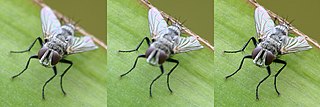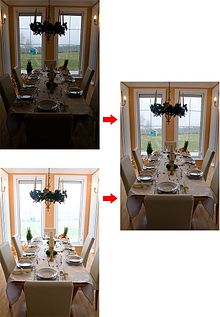
In photography and videography, multi-exposure HDR capture is a technique that creates high dynamic range (HDR) images by taking and combining multiple exposures of the same subject matter at different exposures. Combining multiple images in this way results in an image with a greater dynamic range than what would be possible by taking one single image. The technique can also be used to capture video by taking and combining multiple exposures for each frame of the video. The term "HDR" is used frequently to refer to the process of creating HDR images from multiple exposures. Many smartphones have an automated HDR feature that relies on computational imaging techniques to capture and combine multiple exposures.
In photography, bracketing is the general technique of taking several shots of the same subject using different camera settings, typically with the aim of combining the images in postprocessing. Bracketing is useful and often recommended in situations that make it difficult to obtain a satisfactory image with a single shot, especially when a small variation in exposure parameters has a comparatively large effect on the resulting image. Given the time it takes to accomplish multiple shots, it is typically, but not always, used for static subjects. Autobracketing is a feature of many modern cameras. When set, it will automatically take several bracketed shots, rather than the photographer altering the settings by hand between each shot.

Computational photography refers to digital image capture and processing techniques that use digital computation instead of optical processes. Computational photography can improve the capabilities of a camera, or introduce features that were not possible at all with film-based photography, or reduce the cost or size of camera elements. Examples of computational photography include in-camera computation of digital panoramas, high-dynamic-range images, and light field cameras. Light field cameras use novel optical elements to capture three dimensional scene information which can then be used to produce 3D images, enhanced depth-of-field, and selective de-focusing. Enhanced depth-of-field reduces the need for mechanical focusing systems. All of these features use computational imaging techniques.

Tone mapping is a technique used in image processing and computer graphics to map one set of colors to another to approximate the appearance of high-dynamic-range (HDR) images in a medium that has a more limited dynamic range. Print-outs, CRT or LCD monitors, and projectors all have a limited dynamic range that is inadequate to reproduce the full range of light intensities present in natural scenes. Tone mapping addresses the problem of strong contrast reduction from the scene radiance to the displayable range while preserving the image details and color appearance important to appreciate the original scene content.

The Nikon D200 is a 10.2-megapixel digital single-lens reflex camera that falls between entry-level/midrange DSLR cameras such as the Nikon D40, Nikon D40x, and D80 and high-end models such as the Nikon D2Hs and D2Xs. It was released by the Nikon Corporation in November 2005. The D200 was succeeded by the D300 in August 2007.
High dynamic range (HDR), also known as wide dynamic range, extended dynamic range, or expanded dynamic range, is a dynamic range higher than usual.

In digital photography, exposing to the right (ETTR) is the technique of adjusting the exposure of an image as high as possible at base ISO to collect the maximum amount of light and thus get the optimum performance out of the digital image sensor.

Helicon Filter, also referred to as Helicon, Filter, or as HF, was a proprietary commercial and shareware photo editing software program for Microsoft Windows, similar to such programs as Adobe Photoshop and GIMP, developed and published by Helicon Soft Ltd. Unlike these other programs, Helicon Filter is designed primarily to edit and improve existing photos and not for graphics creation. Helicon Filter's interface also differs from other programs in that compact toolbars and menus containing editing tools are replaced with labeled "filter" tabs, each tab containing labeled edit options specific to a single aspect of the picture. Although some editors used to Photoshop-style programs may initially find this layout unfamiliar and unlike the standard toolbar layout, beginners and those who don't recognize the standard icons generally find this very helpful for getting through the editing process.

Focus stacking is a digital image processing technique which combines multiple images taken at different focus distances to give a resulting image with a greater depth of field (DOF) than any of the individual source images. Focus stacking can be used in any situation where individual images have a very shallow depth of field; macro photography and optical microscopy are two typical examples. Focus stacking can also be useful in landscape photography.

SilverFast is the name of a family of software for image scanning and processing, including photos, documents and slides, developed by LaserSoft Imaging.

HDR PhotoStudio is a discontinued high dynamic range (HDR) graphics application developed by Unified Color for the Windows and macOS operating systems. In addition to being a HDR-merge application, HDR PhotoStudio offered a set of image editing operations that worked in its dynamic range, human color range (gamut), and in high precision. It also had a Color Integrity feature that enabled preserving an image's color tone during image editing operations — for example changing an image's contrast would not change its chromatic data. This problem is usually referred to as "color shift".

The Pentax K-5 is a 16.3-megapixel digital single-lens reflex camera, announced on September 20, 2010. It began shipping in mid-October 2010 and it was replaced by the Pentax K-5 II in the third quarter of 2012.

Image editing encompasses the processes of altering images, whether they are digital photographs, traditional photo-chemical photographs, or illustrations. Traditional analog image editing is known as photo retouching, using tools such as an airbrush to modify photographs or editing illustrations with any traditional art medium. Graphic software programs, which can be broadly grouped into vector graphics editors, raster graphics editors, and 3D modelers, are the primary tools with which a user may manipulate, enhance, and transform images. Many image editing programs are also used to render or create computer art from scratch. The term "image editing" usually refers only to the editing of 2D images, not 3D ones.

Magic Lantern is a firmware add-on for various Canon digital single-lens reflex (DSLR) cameras and the EOS M. It adds features for DSLR filmmaking and still photography, and is free and open-source.

Darktable is a free and open-source photography application and raw developer. Rather than being a raster graphics editor like Adobe Photoshop or GIMP, it comprises a subset of image editing operations specifically aimed at non-destructive raw image post-production. It is primarily focused on improving a photographer's workflow by facilitating the handling of large numbers of images. It is freely available in versions tailored for most major Linux distributions, macOS, Solaris and Windows and is released under the GPL-3.0-or-later.

Luminance HDR, formerly Qtpfsgui, is graphics software used for the creation and manipulation of high-dynamic-range images. Released under the terms of the GPL, it is available for Linux, Windows and Mac OS X. Luminance HDR supports several High Dynamic Range (HDR) as well as Low Dynamic Range (LDR) file formats.
Epsilon photography is a form of computational photography wherein multiple images are captured with slightly varying camera parameters such as aperture, exposure, focus, film speed and viewpoint for the purpose of enhanced post-capture flexibility. The term was coined by Prof. Ramesh Raskar. The technique has been developed as an alternative to light field photography that requires no specialized equipment. Examples of epsilon photography include focal stack photography, High dynamic range (HDR) photography, lucky imaging, multi-image panorama stitching and confocal stereo. The common thread for all the aforementioned imaging techniques is that multiple images are captured in order to produce a composite image of higher quality, such as richer color information, wider-field of view, more accurate depth map, less noise/blur and greater resolution.

Pixel Camera, formerly Google Camera, is a camera phone application developed by Google for the Android operating system. Development for the application began in 2011 at the Google X research incubator led by Marc Levoy, which was developing image fusion technology for Google Glass. It was publicly released for Android 4.4+ on the Google Play on April 16, 2014. It was initially supported on all devices running Android 4.4 KitKat and higher, but became only officially supported on Google Pixel devices in the following years. The app was renamed Pixel Camera in October 2023, with the launch of the Pixel 8 and Pixel 8 Pro.
JPEG XT is an image compression standard which specifies backward-compatible extensions of the base JPEG standard.
Enblend-Enfuse are open source console application created by Andrew Mihal and mostly maintained by Hugin developers. It consists of Enblend, an image blending tool useful for creating panoramas, and Enfuse, an exposure fusion and focus stacking tool that combines the depth of field and dynamic range from multiple images of the same scene (bracketing). Enblend-enfuse accepts images already aligned by other methods.













